If you love mile-high pastrami sandwiches, then this homemade Smoked Pastrami will rock your world! Make incredible homemade pastrami without the weeklong process with our shortcut method that starts with store-bought corned beef, then transforms it through smoking and steaming into something that rivals your favorite deli.
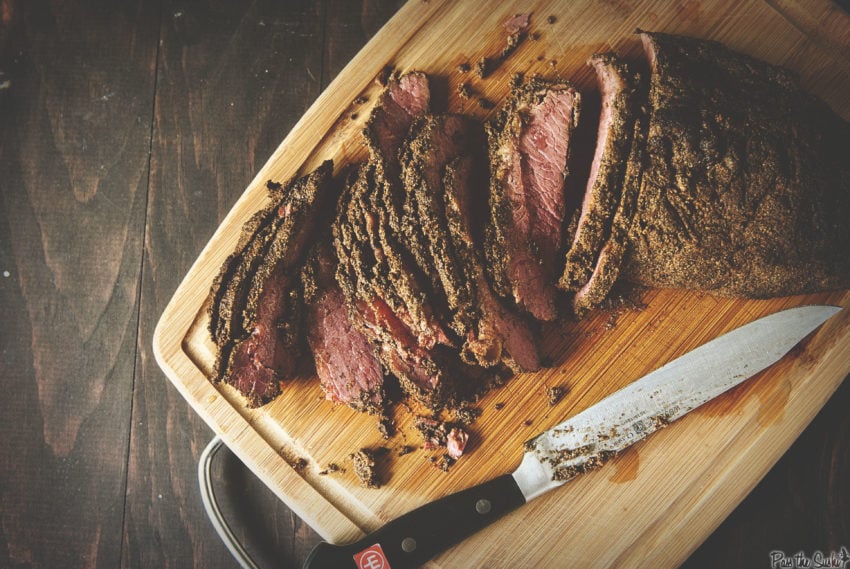
Table of Contents
In this recipe:
The beauty of this approach lies in the brilliant time-saving strategy. By starting with corned beef, you’re already halfway to pastrami perfection. We’ve fine-tuned the spice blend, smoking process, and final steam to create that signature pink center and spice-crusted exterior that defines great pastrami.
Skip over injecting the meat, brining it for days, and cooking it forever and ever. It’s a simple, straightforward recipe and technique that’ll save you time and money because making pastrami yourself is SO much cheaper!
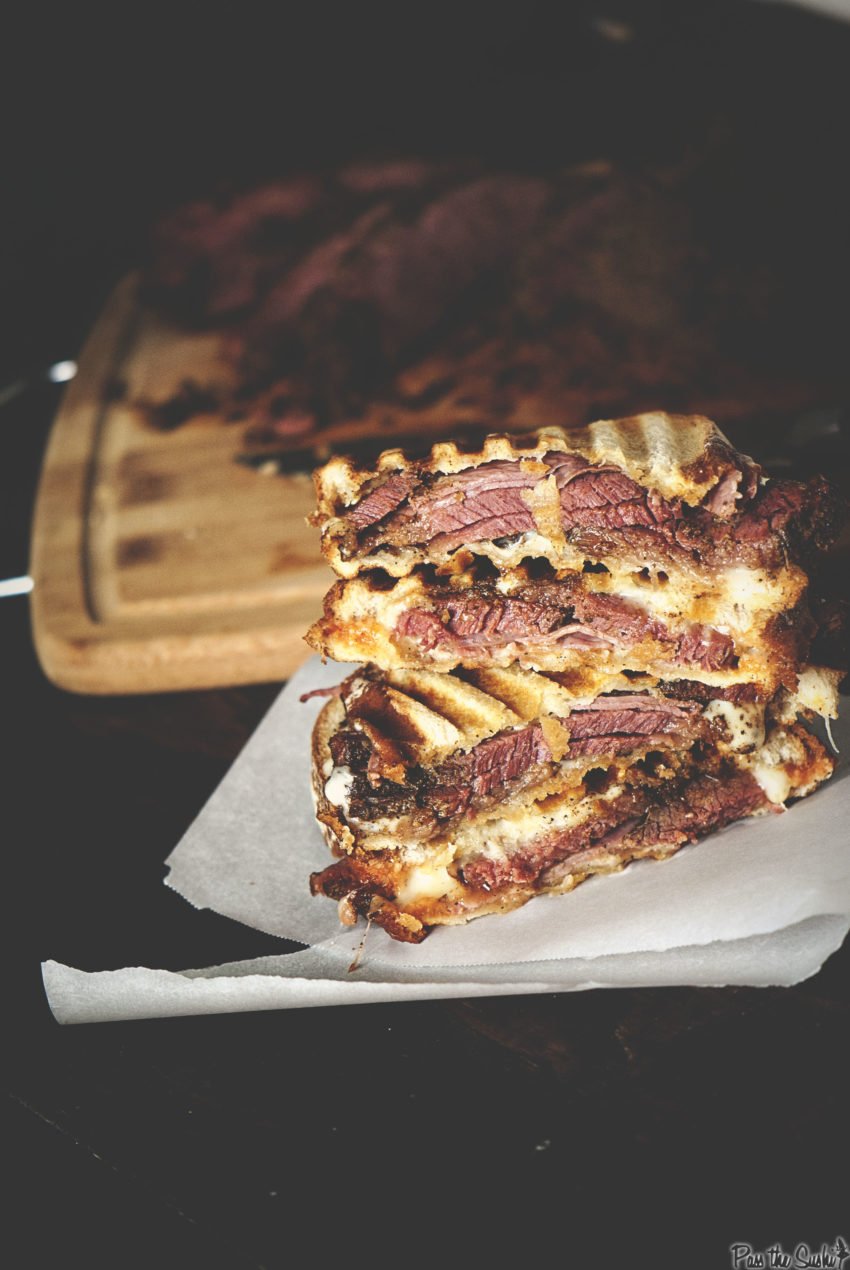
WHAT IS PASTRAMI?
Pastrami vs corned beef – what’s the difference? They both start out the same way – with meat that’s been brined for days in a solution of salt and spices, the curing process.
Traditionally, smoked corned beef is made from beef brisket flat, point, or even whole brisket, while pastrami is made from the deckle, or beef navel, a cut of meat from below the ribs. These days, pastrami is also often made from brisket because it is more commonly available.
Pastrami is also coated in a bold spice rub and herb mixture that further flavors the beef, whereas corned beef is often simmered with some pickling spices.
Finally, they are finished differently. Corned beef is boiled low and slow to break down all the connective tissues, while pastrami is smoked at low temperatures and then steamed. This double process of smoking and steaming helps the connective tissue break down and infuse the meat with smoke, and then steaming further breaks down the connective tissues and infuses the meat with moisture.
Making either corned beef or pastrami from scratch is a days-long labor of love, but you’re in luck because we’ve got a genius hack for you that’ll have you chowing down on thinly sliced pastrami perfection in no time. Around March, corned beef tends to be on sale at the local grocery stores, and it is the perfect time of year to stock up on these. You can freeze the cuts of beef until you’re ready to make this.
Our hack for the cooking process of making beef pastrami from scratch is starting with a prepared store-bought corned beef. Making easy pastrami from this shortcut will shave DAYS off the process.
Remember how both corned beef and pastrami start out the same? Instead of boiling it and serving it like corned beef and cabbage with carrots, we’re going to smoke and then steam it for tender bites.
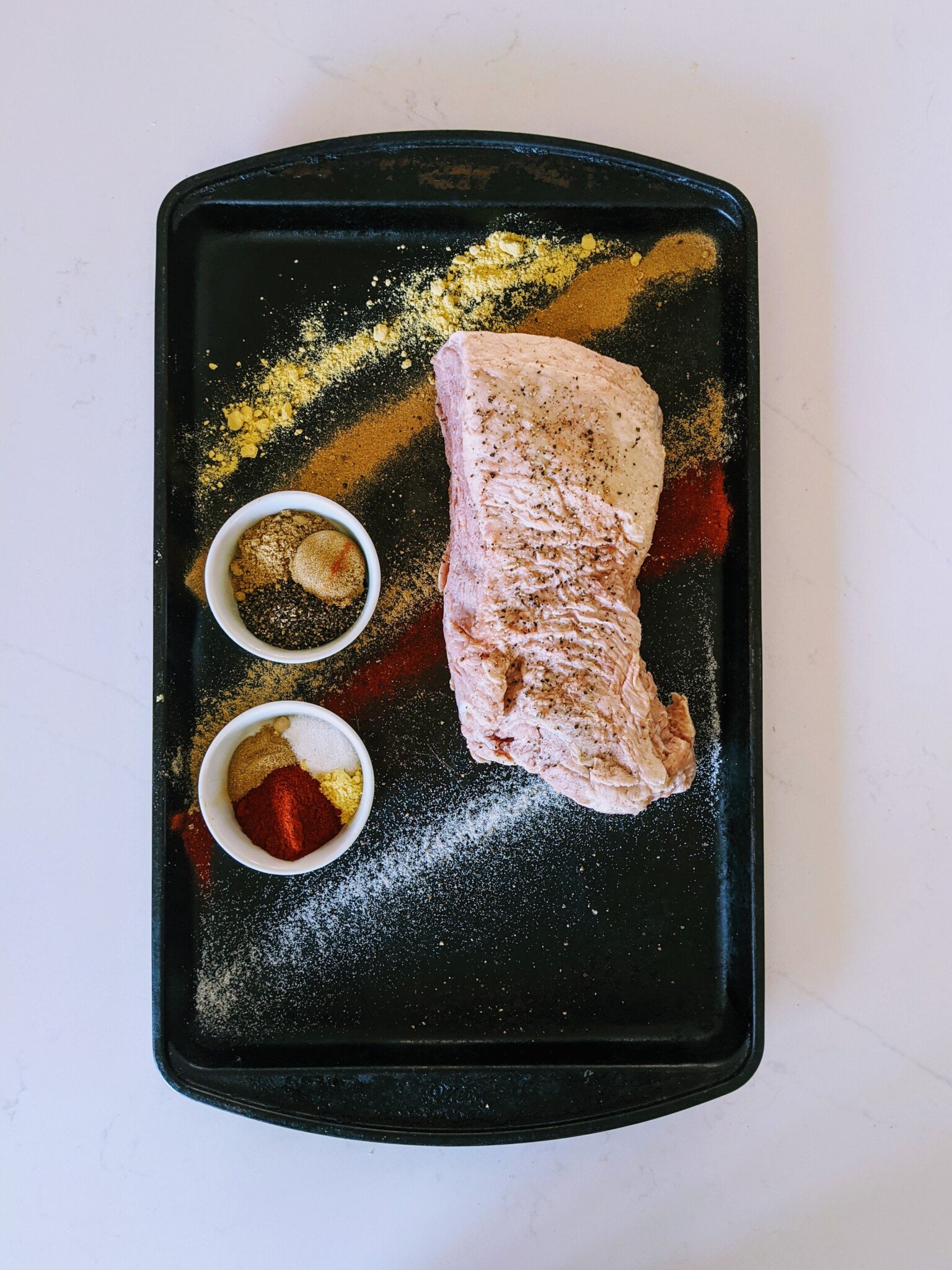
WHAT YOU’LL NEED TO MAKE THIS
- Corned beef – We’re taking a shortcut by using corned beef instead of brining our own.
FOR THE PASTRAMI RUB
- Black pepper – Coarsely ground.
- Coriander powder – or ground toasted coriander seeds
- Mustard powder – or coarse-ground mustard seeds
- Brown sugar – Use light brown sugar.
- Smoked paprika – Smoked paprika has a smokier flavor than regular paprika.
- Garlic powder – Powder, not garlic salt.
- Onion powder – Powder, not onion salt.
Girl Carnivore Expert Tip
If using whole spices, like peppercorns, mustard, and coriander, use a mortal and pestle or spice grinder to grind the whole spices into a coarse powder for the best pastrami flavor.
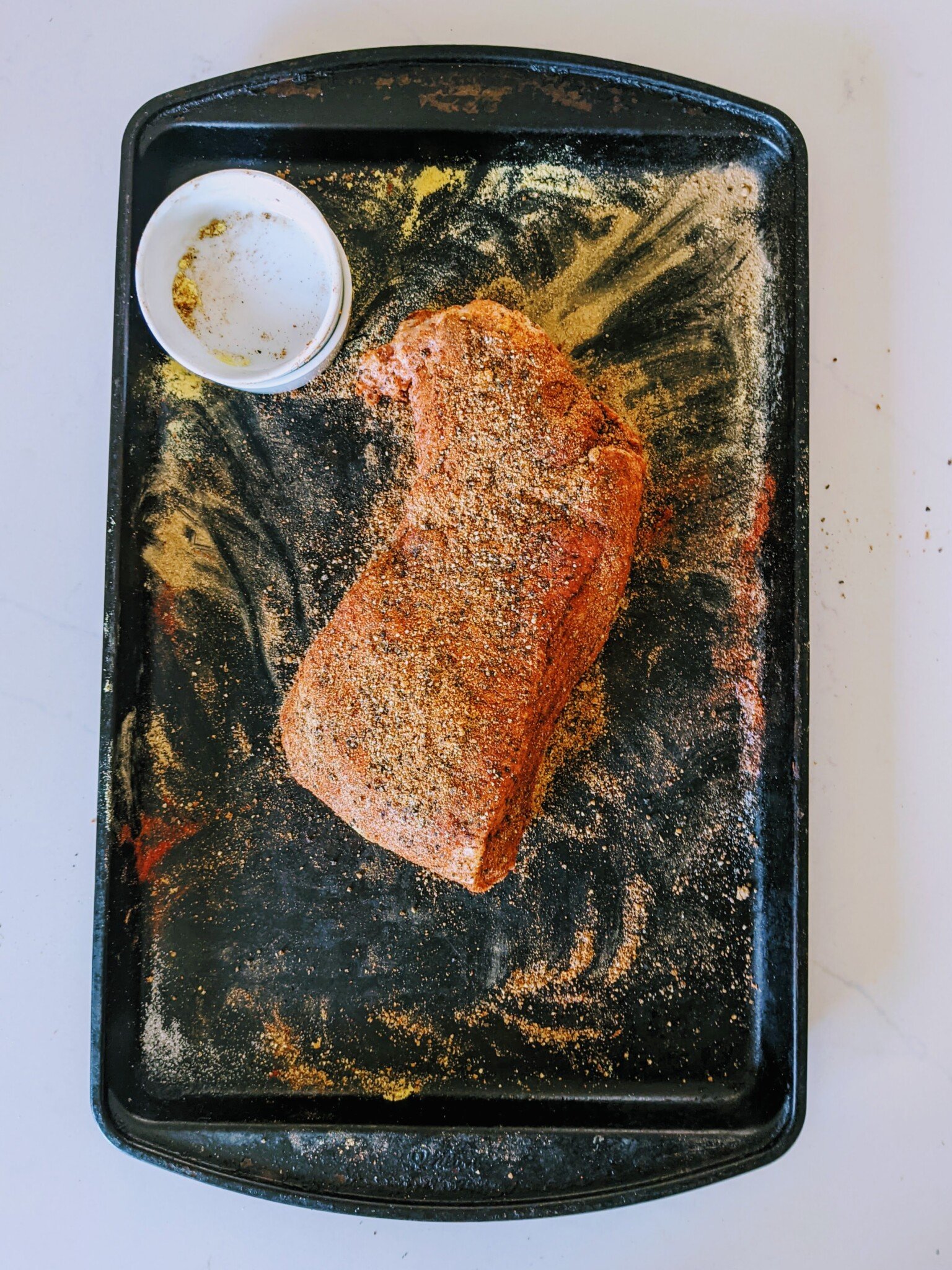
HOW TO MAKE HOMEMADE PASTRAMI FROM CORNED BEEF
- Soak the corned beef brisket in a large pot of cold water to draw out the excess salt from the highly seasoned brine for two days before smoking the pastrami. Keep this pot of soaking beef in the fridge.
- The next morning, remove the beef from the water and pat it dry with paper towels.
- Make the pastrami seasoning by combining the dry rub ingredients in a bowl.
- Rub the beef with a thick layer of spices, wrap it tightly in plastic wrap, and refrigerate it overnight.
SMOKE THE PASTRAMI
- Prep the smoker for 225F for indirect heat by building a 2-zone fire. Add water to the water pan and wood chunks or chips to the lit charcoal.
- Rest the corned beef at room temperature for about 30 minutes before smoking.
- Place the meat with the fat cap up on the smoker and cook until the internal temperature reaches 190F.
- Remove the beef from the smoker, wrap it in foil, and cool completely.
HOW TO STEAM PASTRAMI
Steaming pastrami is easy! Grab some foil, and here’s what you do:
- Slice off as much meat as you’ll need – slice it thinly and against the grain.
- Place the meat in the center of a large sheet of aluminum foil. Fold the edges up around it, but don’t pinch it shut.
- Place the pastrami on a steamer or metal wire rack above simmering water. Don’t let the meat touch the water. Steam until tender and heated through.
- Steaming whole pastrami? Place it in a large foil sheet and cover it tightly with foil. Steam it for 2 hours, adding water as needed, until the meat reaches 200F with an instant-read thermometer.
When ready to serve, slice it thin for a classic smoked pastrami sandwich with Russian dressing; try these mini sliders or jazz up a hot dog with a Reuben version if you’re feeling wild and crazy.
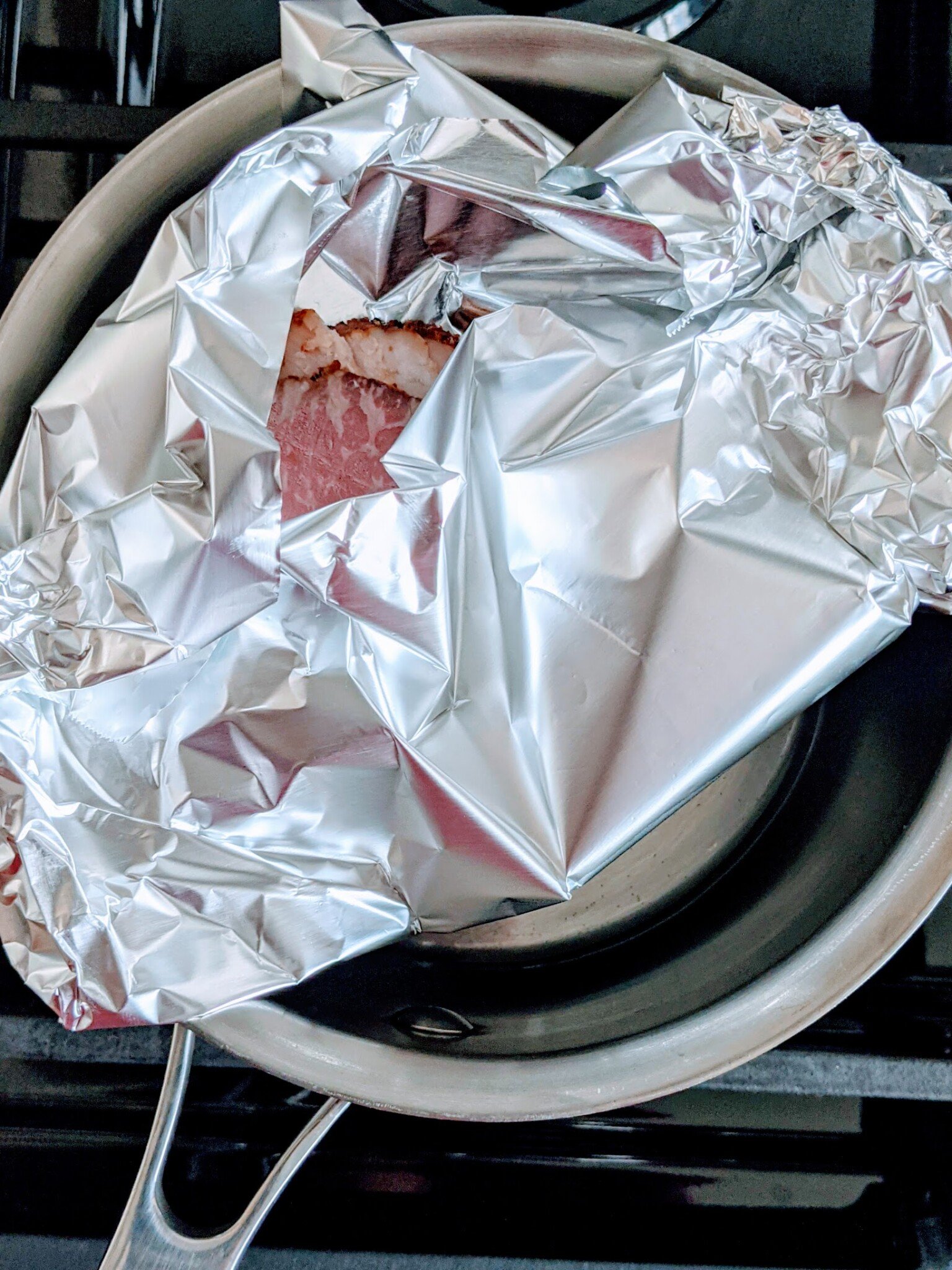
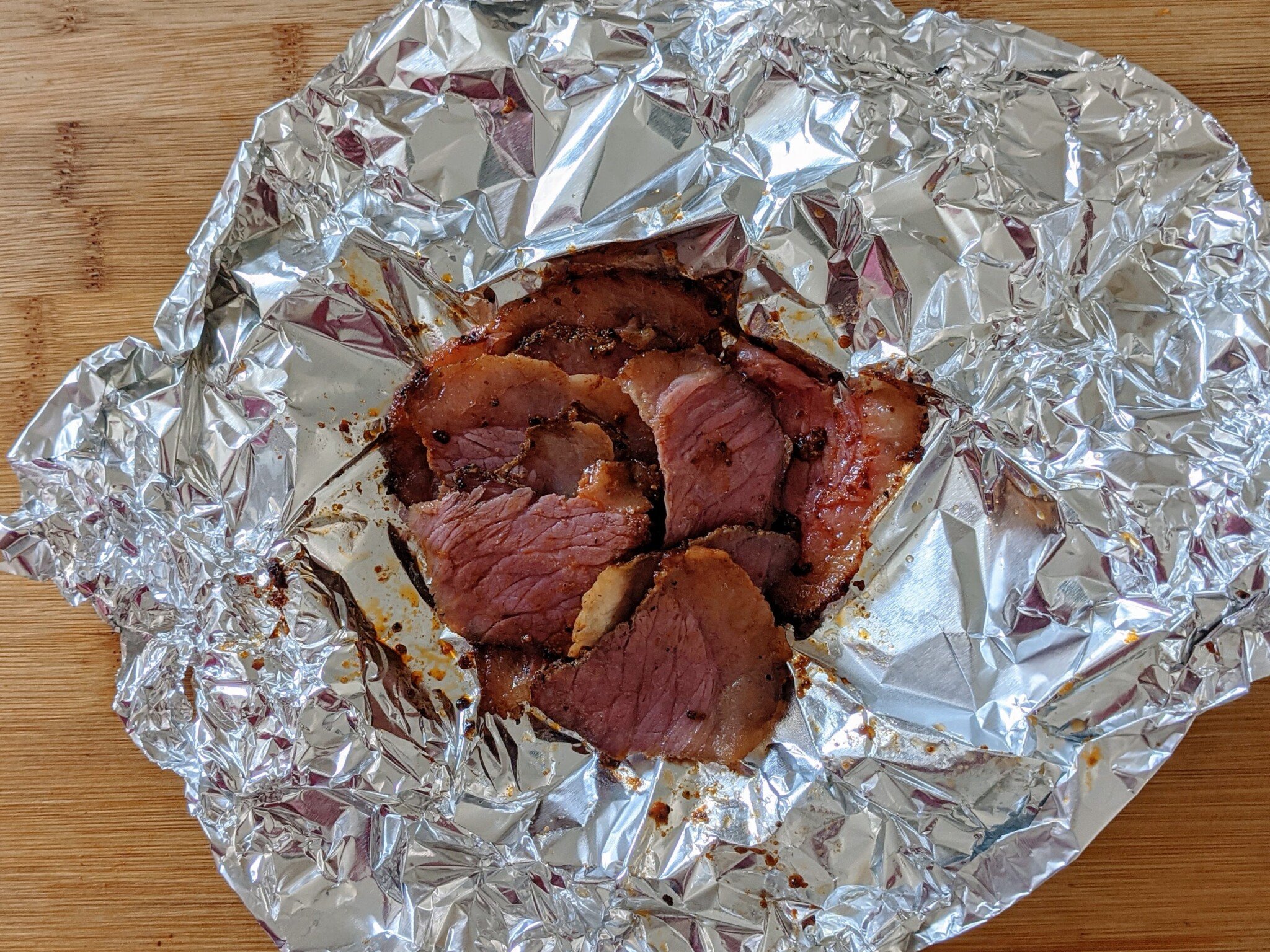
WHAT WOOD DO YOU USE TO SMOKE PASTRAMI
Everyone has their favorite kind of smoking wood chips, but if you are ready to get serious about your wood smoking (and we know you are), you want to pair the best smoke flavors with whatever you’re smoking.
- When it comes to smoking pastrami, you want the flavors of the meat to pull through without a smoking wood that will overshadow that. You get a smoke flavor that carries all the brining flavors through with fruit or sweet wood. Going with a more savory, acrid wood smoke like mesquite tends to overshadow everything else.
- With that in mind, we recommend using something sweeter and milder, like alder, maple, or cherry. Hickory wood is also suitable for a strong but not overwhelming flavor.
- This recipe works whether grilling on a Traeger pellet grill, Pit Barrel drum-style grill, or charcoal smoker. For a pellet grill, we recommend Jack Daniel’s Charcoal pellets for added subtle smoke flavor.
WHAT TO SERVE WITH SMOKED AND STEAMED PASTRAMI
If you’re not just shoveling thinly sliced pastrami in your mouth with a fork (like we do), you should serve this shaved pastrami on a fresh hoagie roll, pumpernickel, or marbled rye bread with a slice of melty Swiss cheese and colesla. Check out my deli classic corned beef sandwich, aka a Reuben sandwich.
Serve your hearty pastrami sandwich with a side of smoked cabbage, sauerkraut, smoked potato salad, crispy beef tallow French fries, or even just potato chips, and dig in!
Leftovers & Reheating
We recommend storing the pastrami after smoking and cooling, wrapped in foil. Then, only steaming as much as you’re going to serve each time for ultimate freshness! If you reheat it all at once, you’re just drying it out.
Leftover smoked pastrami will last in an airtight container in the refrigerator for 3-5 days or in the freezer for 1-2 months.
To reheat: Thaw it in the fridge if frozen, then use the steam method to reheat it. Adding a pot of bubbling water to the oven creates a moist environment that allows everything to warm back up while remaining juicy and flavorful. We usually heat it at 200F for about 2 hours, but this will depend on how much you’re reheating.
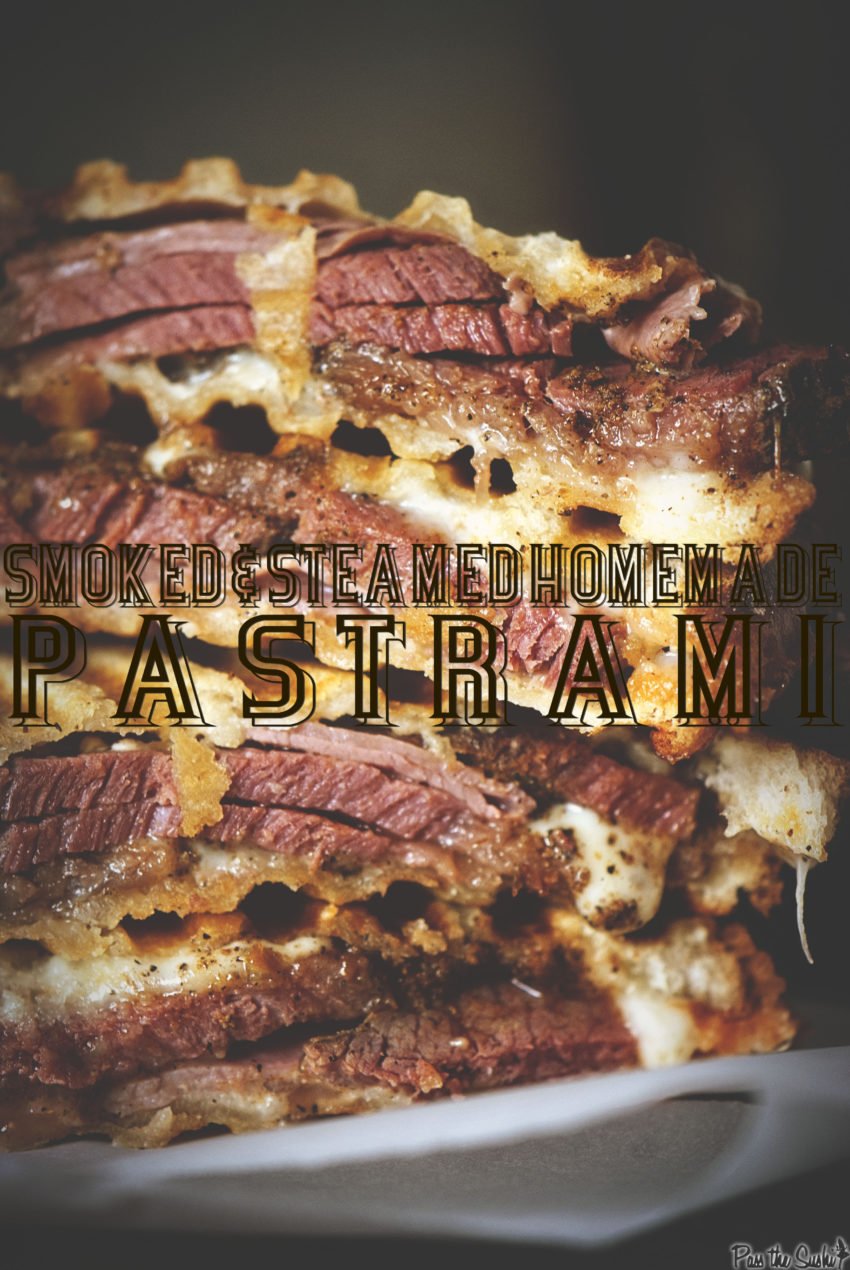
MORE SMOKER RECIPES TO TRY
With this homemade smoked pastrami recipe, you can get a taste of classic New York City pastrami in your own kitchen!
Have you tried this recipe? Do us a favor and rate the recipe card with the ⭐ ⭐ ⭐ ⭐ ⭐ and drop a comment to help out the next reader.
Smoked & Steamed Pastrami Recipe
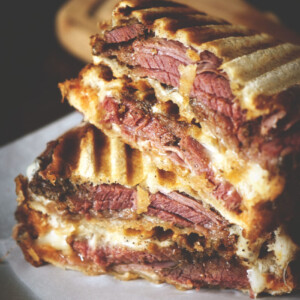
Recommended Equipment
- Smoker
Ingredients
For the Beef
- 4 lbs corned beef
For the Rub
- 4 tbs fresh coarsely ground black pepper
- 2 tbs coriander powder
- 1 tspn ground mustard
- 1 tbs light brown sugar
- 1 tbs smoked paprika
- 2 tspn garlic powder
- 2 tspn onion powder
Instructions
Soak the Corned Beef
- Two nights before ready to smoke: place the corned beef in a large pot of cold water and place in the fridge to draw out excess salt.
Rub the Corned Beef
- Combine the black pepper, coriander, mustard, brown sugar, paprika, garlic powder, and onion powder in a bowl.
- Remove the corned beef from the water and pat dry.
- Rub the corned beef with a thick layer of rub, wrap tightly with plastic wrap and refrigerate overnight.
Smoke the Meat
- Allow the corned beef to sit at room termperaturefor 30 minutes while the grill come's to temp.
- Prep smoker for 225 degrees F with indirect heat by building a 2-zone fire.
- When the coals are ready, add wood chunks or chips to the lit coals. Waiting until the steady streak of smoke pours out clear before adding the meat.
- Add the drip pan filled with water below the grill grate or on the side as needed depending on your grill.
- Place corned beef, fat side up in smoker and smoke until internal temperature reaches 190 degrees F.
- Remove from smoker, wrap in aluminum foil and cool completely (I placed in the fridge overnight).
Steam the Meat
- When ready to serve: Slice off just enough of the meat in thin strips against the grain.
- Place the meat in the center of a sheet of aluminum foil and fold the edges up around it, but do not pinch shut.
- Steam the pastrami by placing the meat on a steamer rack, or metal wire rack above simmering water in a large pan on the stove top, making sure the meat does not touch the water.
- Steam until the slices are tender and heated through, about 15 minutes.
- If steaming the whole pastrami, wrap in foil as above and cover with lid or aluminium foil and steam for 2 hours, adding water as needed, or until the meat reaches 200 degrees F.
- Slice and serve.
Video
Notes
- We smoked with Cowboy all-natural hardwood briquets and Western Wood hickory wood, but post oak or pecan also work for this recipe.
- Whether grilling on a Traeger pellet grill, Pit Barrel drum-style grill, or charcoal smoker, this recipe works.
- For a pellet grill, we recommend Jack Daniel’s Charcoal pellets for added subtle smoke flavor.
- If you’re up for the challenge, toast your own mustard seeds and crush them in a spice grinder for a bolder flavor.
Nutrition
Bookmark this recipe now!
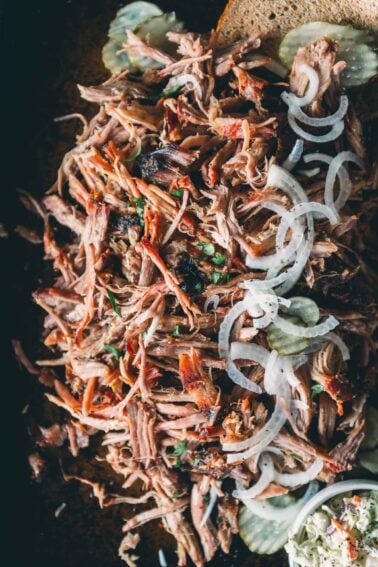
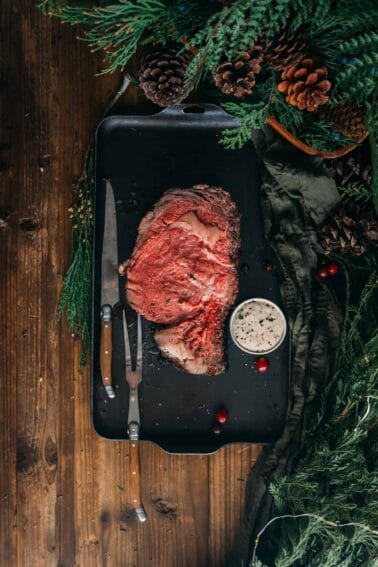
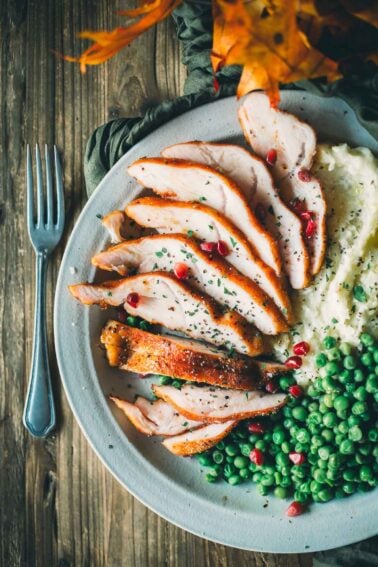
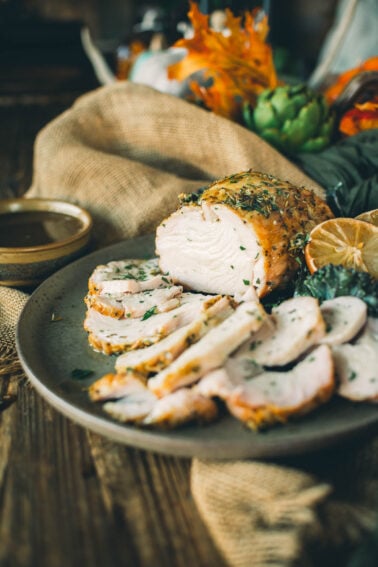

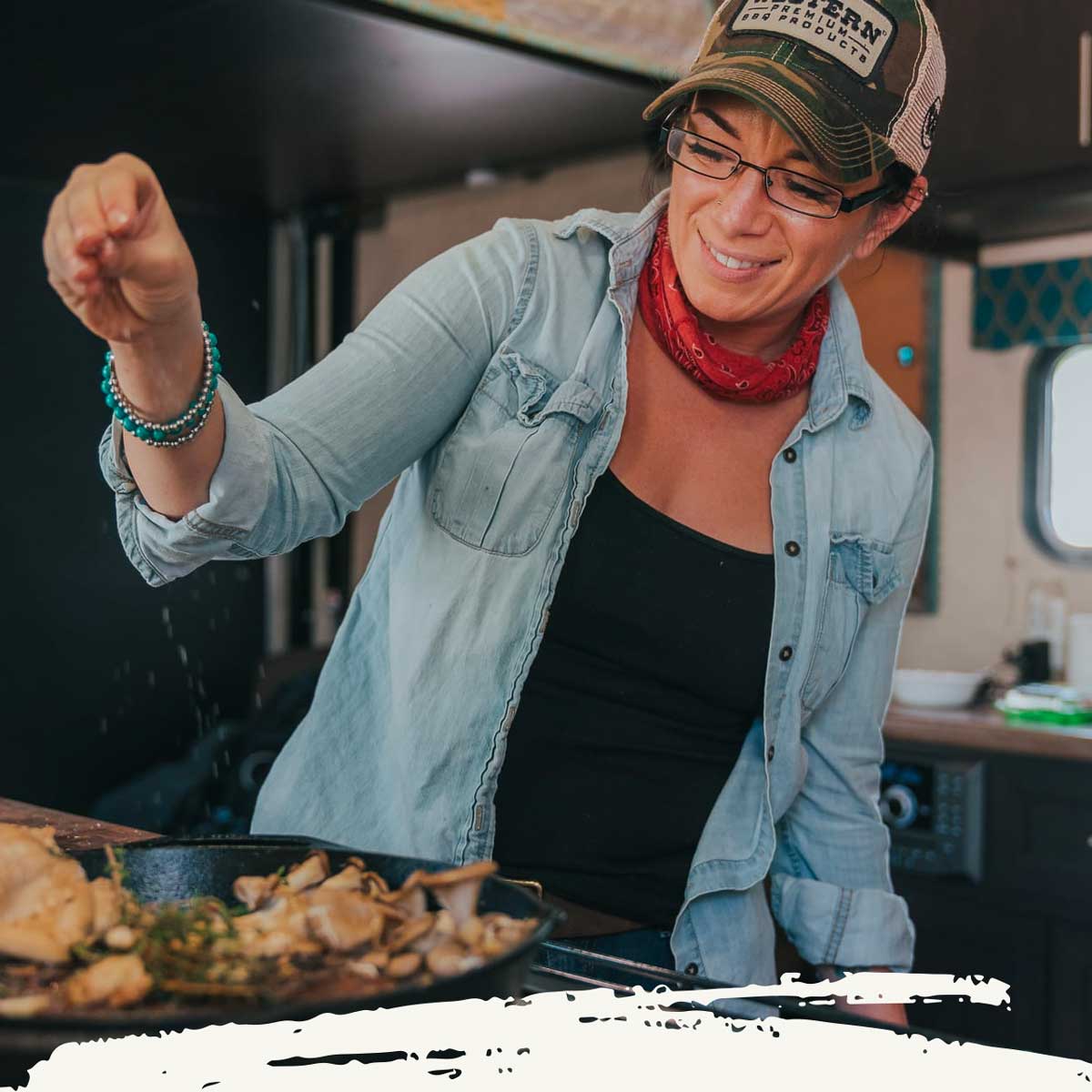
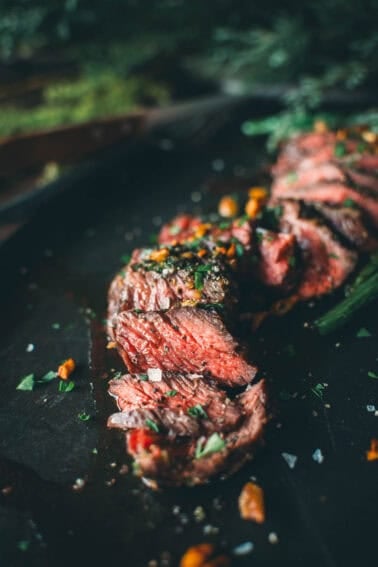
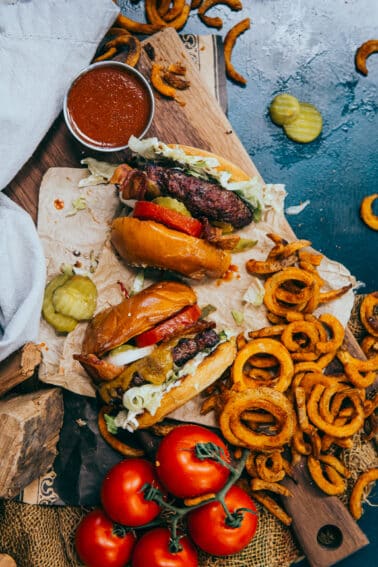
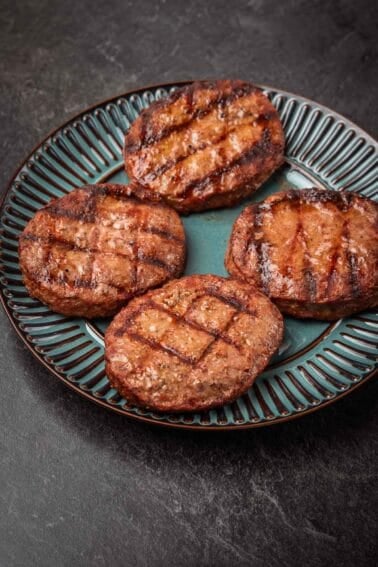
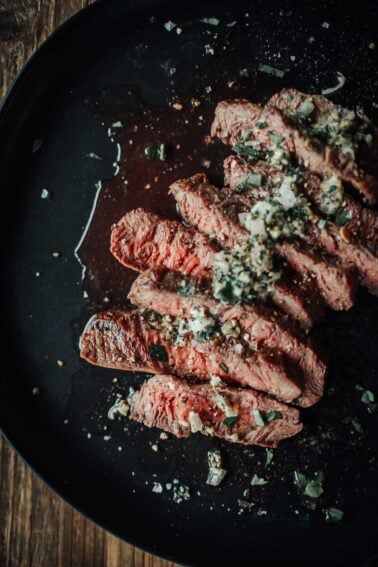









Hi, I’m wondering how long the meat is in the smoker?
Hey hey Ms Martella, this will depend on the size of your corned beef. We recommend cooking to temp, not time for this recipe as the internal temperature is the most important factor for getting the pastrami texture just right. We aim for around 190 degrees F as we want slices, not for the meat to shred.
Just made this. It is quite a process but the result is moist, tender pastrami. I did find it very spicy from all of the cracked black pepper so ended up trimming a lot of the outer surface off. Looking forward to sandwiches tomorrow night!
Just got done with this, and it is amazing! Thanks so much!
As kid from the Bronx and a veteran of many a pastrami I can’t help but add my 2¢! The recipe is a good one and should produce a delicious pastrami, although I would increase the ground coriander by a T or so. However, to really appreciate your pastrami you should start with a raw brisket and corn it yourself as a first step. Yes, it adds days to the process but it is well worth the effort. Sure, I have made pastrami using a commercial corned beef; it is REALLY good, but it cannot compare to doing it from scratch. My only other suggestion is that before rubbing your corned beef with the dry rub, coat your meat with a layer of yellow mustard. Trust me, it helps both in flavor and in adhering the rub to the meat. Don’t worry, your pastrami will not taste like mustard – but even if it did, what could be bad!
Look delicious, I’ll have to try them :))
Thanks for sharing.
About how long of a smoke does this take to get to 190? Would it be worthwhile to wrap in butcher paper or foil partway through the smoke? I’m trying to determine if I want to try and smoke this the weekend before I need the pastrami or the night before (which would be a weeknight, so some of the smoking would be while I’m asleep).
This made the best pastrami ever. Followed your directions and we had the best tasting pastrami ever.
Thanks for sharing.